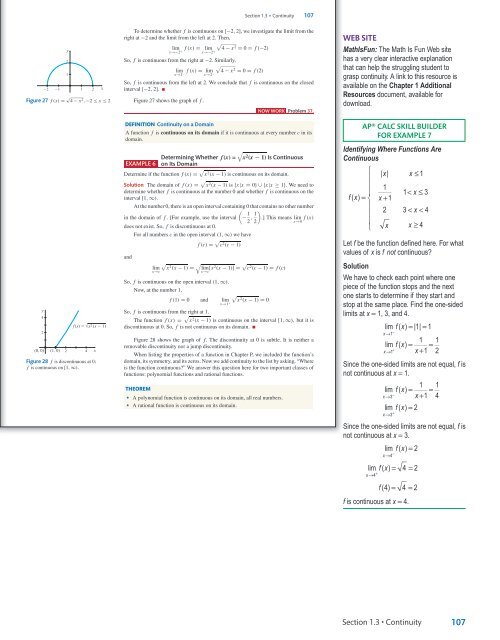Sullivan Microsite DigiSample
Create successful ePaper yourself
Turn your PDF publications into a flip-book with our unique Google optimized e-Paper software.
<strong>Sullivan</strong> AP˙<strong>Sullivan</strong>˙Chapter01 October 8, 2016 17:4<br />
Section 1.3 • Continuity 107<br />
22 21<br />
y<br />
2<br />
1<br />
Figure 27 f (x) = √ 4 − x 2 , −2 ≤ x ≤ 2<br />
y<br />
4<br />
2<br />
(0, 0)<br />
(1, 0)<br />
1<br />
2 4<br />
2<br />
x<br />
x<br />
f (x) x 2 (x 1)<br />
Figure 28 f is discontinuous at 0;<br />
f is continuous on [1, ∞).<br />
To determine whether f is continuous on [−2, 2], we investigate the limit from the<br />
right at −2 and the limit from the left at 2. Then,<br />
√<br />
lim f (x) = lim<br />
x→−2 +<br />
4 − x<br />
2<br />
= 0 = f (−2)<br />
x→−2 +<br />
So, f is continuous from the right at −2. Similarly,<br />
lim<br />
x→2 −<br />
√<br />
f (x) = lim 4 − x 2<br />
= 0 = f (2)<br />
x→2 −<br />
So, f is continuous from the left at 2. We conclude that f is continuous on the closed<br />
interval [−2, 2]. ■<br />
Figure 27 shows the graph of f .<br />
DEFINITION Continuity on a Domain<br />
NOW WORK Problem 37.<br />
A function f is continuous on its domain if it is continuous at every number c in its<br />
domain.<br />
EXAMPLE 6<br />
√<br />
Determining Whether f(x) = x 2 (x − 1) Is Continuous<br />
on Its Domain<br />
Determine if the function f (x) = √ x 2 (x − 1) is continuous on its domain.<br />
Solution The domain of f (x) = √ x 2 (x − 1) is {x|x = 0} ∪{x|x ≥ 1}. We need to<br />
determine whether f is continuous at the number 0 and whether f is continuous on the<br />
interval [1, ∞).<br />
At the number 0, there is an open interval containing 0 that contains no other number<br />
( )<br />
in the domain of f . [For example, use the interval − 1 2 , 1 2<br />
.] This means lim f (x)<br />
x→0<br />
does not exist. So, f is discontinuous at 0.<br />
and<br />
For all numbers c in the open interval (1, ∞) we have<br />
f (c) = √ c 2 (c − 1)<br />
√<br />
lim x 2<br />
(x − 1) = √ lim[x 2 (x − 1)] = √ c 2 (c − 1) = f (c)<br />
x→c<br />
x→c<br />
So, f is continuous on the open interval (1, ∞).<br />
Now, at the number 1,<br />
So, f is continuous from the right at 1.<br />
f (1) = 0 and lim<br />
x→1 + √<br />
x<br />
2<br />
(x − 1) = 0<br />
The function f (x) = √ x 2 (x − 1) is continuous on the interval [1, ∞), but it is<br />
discontinuous at 0. So, f is not continuous on its domain. ■<br />
Figure 28 shows the graph of f. The discontinuity at 0 is subtle. It is neither a<br />
removable discontinuity nor a jump discontinuity.<br />
When listing the properties of a function in Chapter P, we included the function’s<br />
domain, its symmetry, and its zeros. Now we add continuity to the list by asking, “Where<br />
is the function continuous?” We answer this question here for two important classes of<br />
functions: polynomial functions and rational functions.<br />
THEOREM<br />
• A polynomial function is continuous on its domain, all real numbers.<br />
• A rational function is continuous on its domain.<br />
WEB SITE<br />
MathIsFun: The Math Is Fun Web site<br />
has a very clear interactive explanation<br />
that can help the struggling student to<br />
grasp continuity. A link to this resource is<br />
available on the Chapter 1 Additional<br />
Resources document, available for<br />
download.<br />
AP® Calc Skill Builder<br />
for Example 7<br />
Identifying Where Functions Are<br />
Continuous<br />
⎧<br />
⎪<br />
⎪<br />
⎪<br />
fx ( ) = ⎨<br />
⎪<br />
⎪<br />
⎪<br />
⎩<br />
| x| x ≤ 1<br />
1<br />
1< x ≤3<br />
x + 1<br />
2 3< x < 4<br />
x<br />
x ≥ 4<br />
Let f be the function defined here. For what<br />
values of x is f not continuous?<br />
Solution<br />
We have to check each point where one<br />
piece of the function stops and the next<br />
one starts to determine if they start and<br />
stop at the same place. Find the one-sided<br />
limits at x = 1, 3, and 4.<br />
lim fx ( ) = |1| = 1<br />
x→1<br />
− 1 1<br />
lim fx ( ) = =<br />
x→ 1<br />
+ x + 1 2<br />
Since the one-sided limits are not equal, f is<br />
not continuous at x = 1.<br />
1 1<br />
lim fx ( ) = =<br />
x→3<br />
− x + 1 4<br />
lim fx ( ) = 2<br />
x→ 3<br />
+<br />
Since the one-sided limits are not equal, f is<br />
not continuous at x = 3.<br />
lim fx ( ) = 2<br />
x→4<br />
−<br />
lim fx ( ) = 4 = 2<br />
→ + f (4) = 4 = 2<br />
x 4<br />
f is continuous at x = 4.<br />
Section 1.3 • Continuity 107<br />
TE_<strong>Sullivan</strong>_Chapter01_PART I.indd 4<br />
11/01/17 9:58 am




